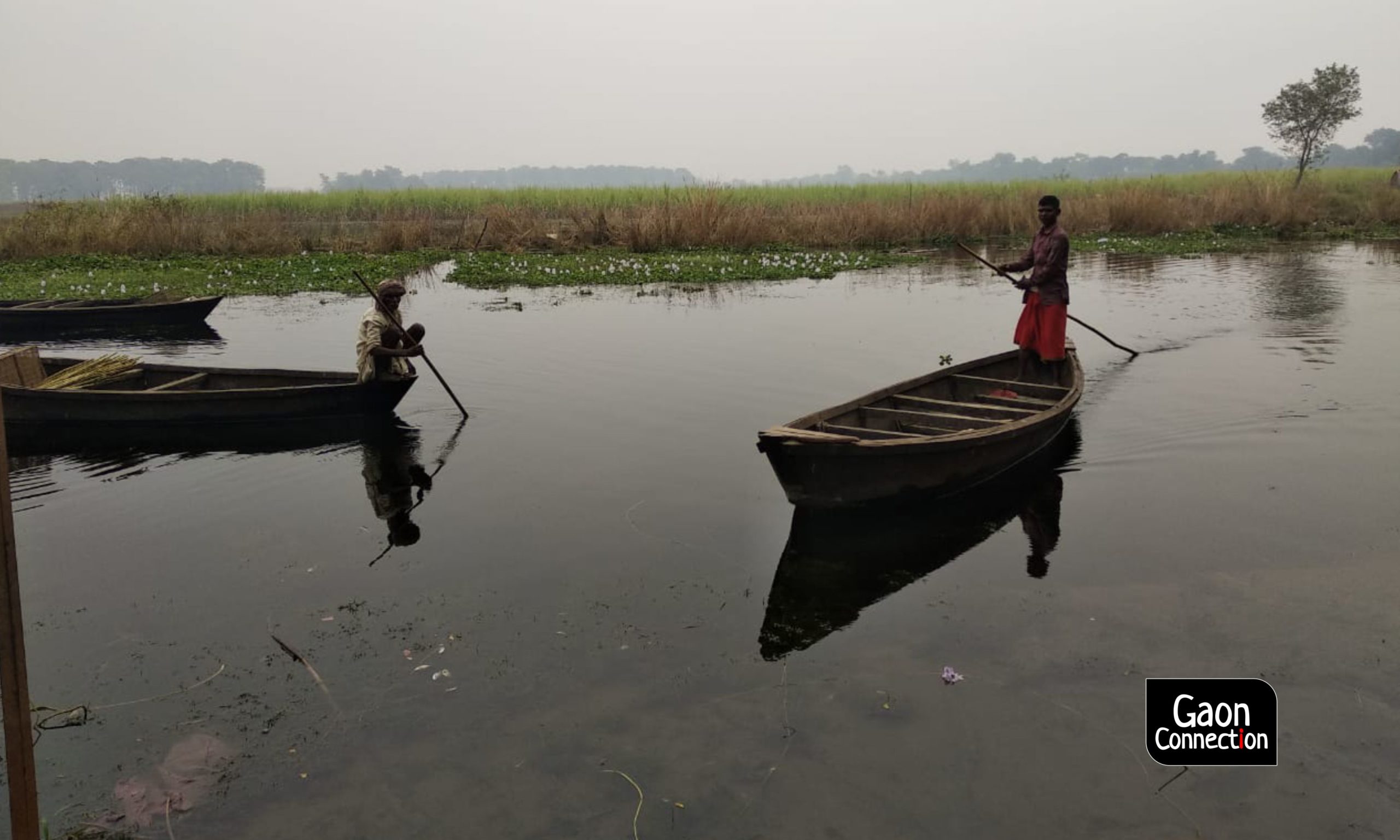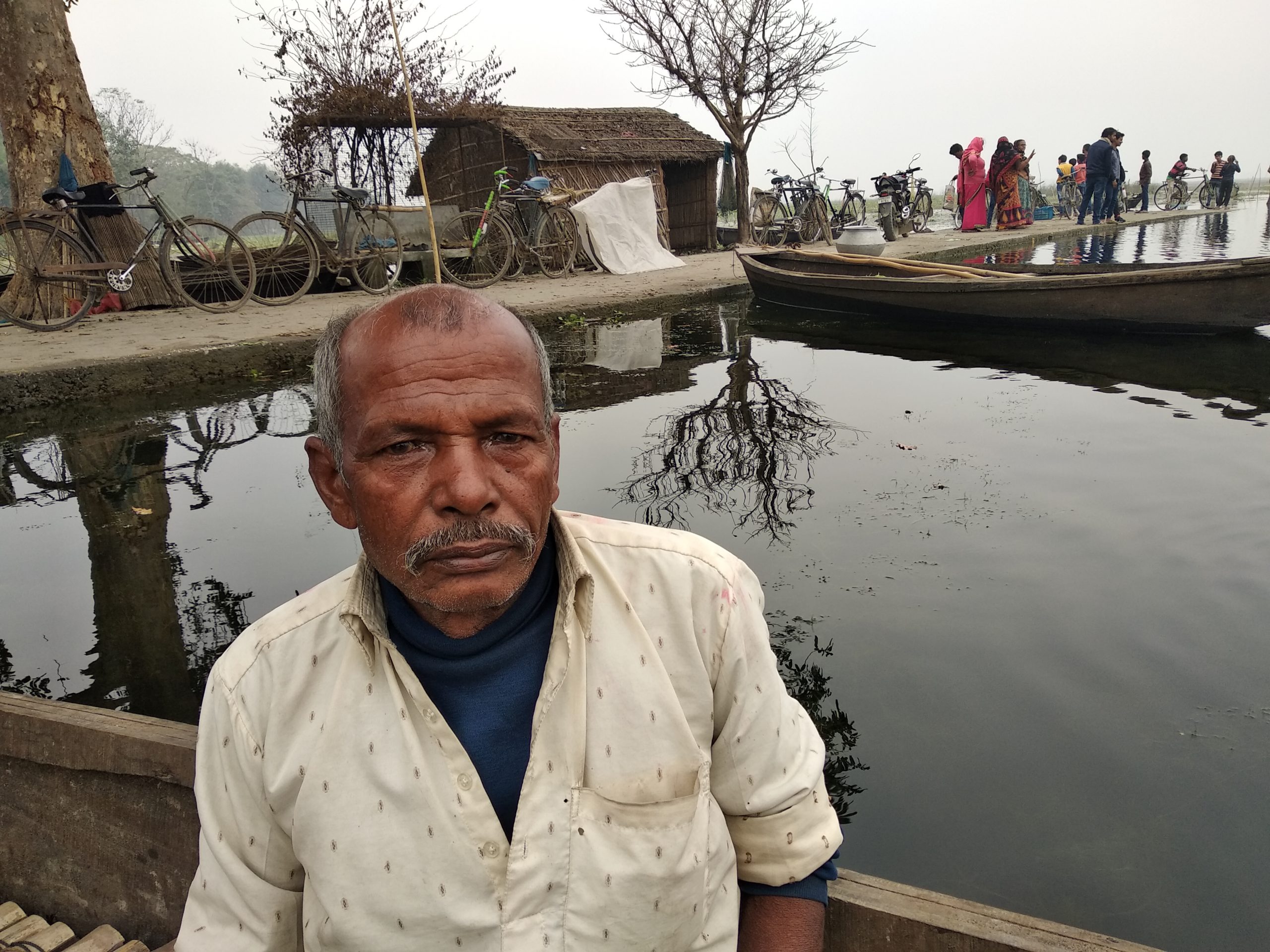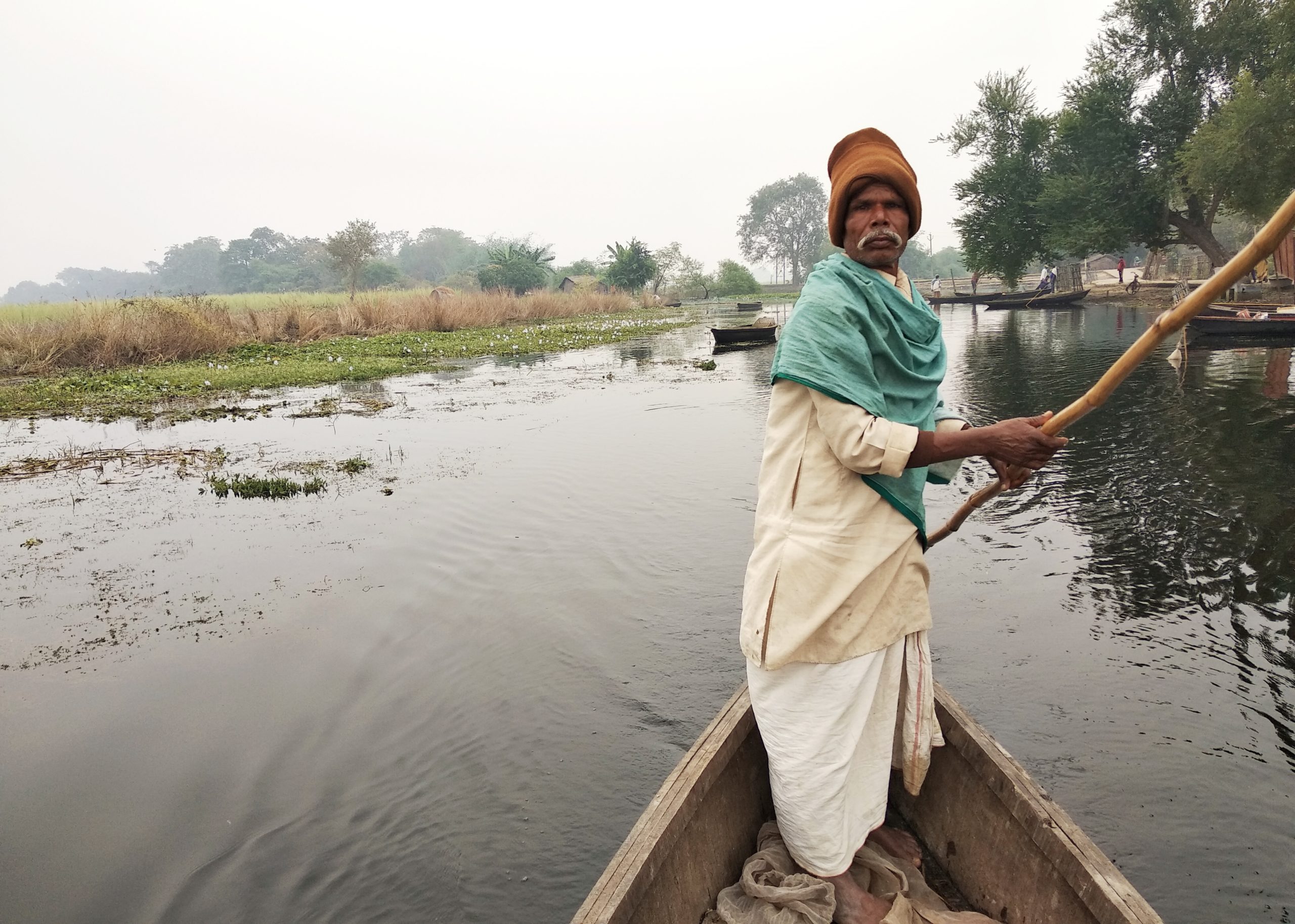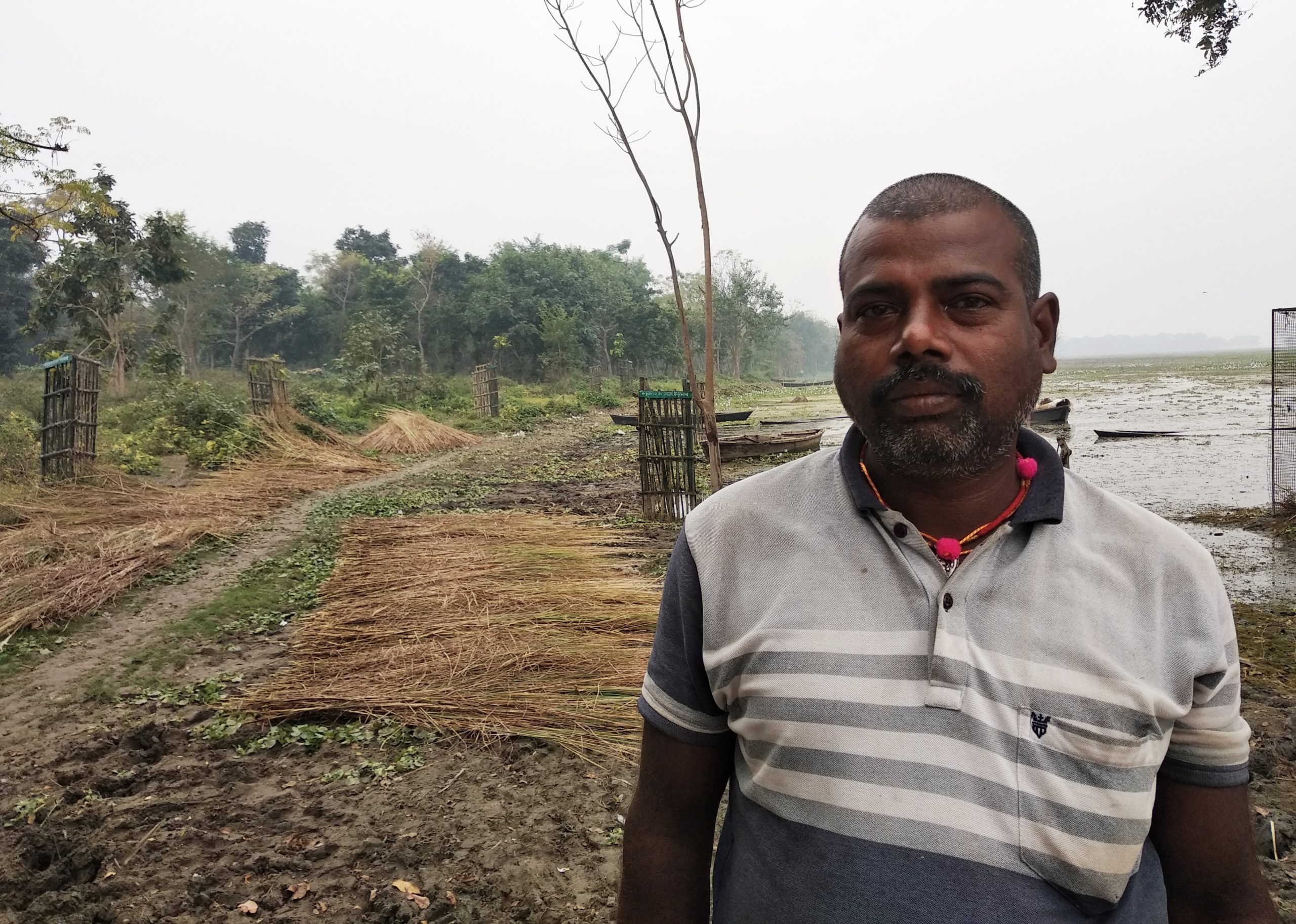Kabar Taal, Bihar’s first Ramsar site: Will this new tag help boost livelihoods of fishers?
Nearly 15,000 families in 17 villages around the 6,311-hectare Kabar taal in Begusarai depend on the wetland for fishing. The taal often goes dry, forcing fishers to migrate in search of work. The Ramsar tag is expected to rejuvenate the waterbody and benefit the local fishing communities.


Around 15,000 fisher families are dependent on the Kabar taal for their livlihood and they are hoping that Ramsar site declaration will enhance their income. Photo: Umesh Kumar Ray
Begusarai, Bihar.
Seventy-year-old Lalo Sahni, a resident of Manjhaul village in Begusarai, belongs to the mallah OBC community of fisherfolk in Bihar. He has spent decades fishing in Kabar taal, a 6,311 hectares (63.11 sq km) large wetland which has recently been designated as the first Ramsar site of the state indicating the importance of protecting and conserving the wetland. But his three sons have migrated to Bengaluru in Karnataka, over 2,200 kilometres away, where they work as labourers at a construction site. Lalo is both lonely and despondent.
“Our ancestors have been fishing in Kabar taal since the time of the British. It is our profession to catch and sell fish from the lake,” he told Gaon Connection. “But, fishing is no more profitable as the taal often dries up. Fish catch has declined sharply. There is little earning,” he added.

However, the recent move of Kabar taal being designated as a Ramsar site of international importance under the Ramsar Convention has infused hope in Sahni that his sons may return home as the state government has drawn up a plan to revive Kabar taal and support the livelihood of the nearly 1.5 crore people of the mallah community, in Bihar. The taal is already a protected area under the Wildlife (Protection) Act 1972.

There is a plan to identify the inlets that flow into the lake. “The water in Kabar lake comes not only from the monsoon rains but also from 14 inlets which are connected to the lake,” Dipak Kumar Singh, principal secretary, department of environment, forest and climate change, informed Gaon Connection. But these inlets are choked and have to be cleared if the Kabar taal is to be restored, he said.
Meanwhile, the state government also plans to revive the livelihood of thousands of fishers dependent on this taal. “We have sent a proposal to the Central Government to exclude 3,300 hectare area of Kabar from the Wildlife Act. If the Centre accepts our proposal, then fishermen can freely fish in 3,300 hectares of the wetland,” Santosh Tiwari, additional principal chief conservator of forest of the department of environment, forest and climate change, told Gaon Connection.
The idea is that conservation should not exclude the local people, but should benefit their livelihoods.
A source of sustenance
The Kabar taal is spread over 6,311 (63.11 sq km) hectares area in Begusarai district of north Bihar. It is one of the largest ox-bow lakes in Asia formed by the Budhi Gandak river, that flows about 10 km away from the wetland. Ox-bow lakes are wetlands formed by meandering rivers.
Two sources of water feed the Kabar taal. The first is from the monsoon rains and the second from the 14 inlets that originate from the dozen other wetlands, which are connected to the Budhi Gandak river, and carry water into Kabar.
There are 17 villages around the Kabar taal with 15,000 fisher families dependent on it for their survival. It has been a struggle for these landless fishing communities as the taal dries up periodically leaving them with no means of earning and forcing them to migrate. The fishing community is one of the poorest sectors of the society that depends entirely on fishing and marketing, says a NITI Ayog report.
Over the years, many of the species of fish have vanished from the lake. “Earlier fish like mangur, kavai, boari and dhalwa were available in abundance in the lake, which used to fetch a good price in the market, but now the fishes which are available in the wetland are sold hardly at 80-90 rupees per kg,” Shambhu Sahni a 67-year-old local fisherman told Gaon Connection. He said their income has almost halved. While once, they may have earned between Rs 15,000 and Rs 20,000 a month, now their income has come down to Rs 10,000.

“There is neither much fish left in Kabar taal, nor do we get a good price for them,” said Lalo, who often takes tourists for a boat ride in the wetland as a temporary source of income. “Today I have managed to catch only two kilos of fish, which will fetch me only one fifty or two hundred rupees. How will my family survive with this money,” he asked.
Like Lalo, 40-year-old Pramod Sahni of Manjhaul village also catches fish for a living at the Kabar taal. “Since 2008, Kabar lake has been drying up almost every year,” he told Gaon Connection. Sometimes, there is such little water left in the lake that only a few fishermen can catch fish, he said. “Whenever Kabar taal has dried up in the past, I have had to work at construction sites in Patna, or even moved to Maharashtra and Gujarat because we have neither cultivable land here nor any other expertise,” he said.
The 40-year-old sounded hopeful because the taal was declared a wetland of international importance by the Ramsar Convention on July 21 this year. It is the first wetland in Bihar to get the tag, and the 41st such waterbody in India to have been declared as a Ramsar site. According to the Ramsar information sheet published on 16 October 2020, Kabar taal teems with water birds in the winters, and is visited by over 59 species during their annual migration cycle. Besides, it also supports 206 resident birds. Recorded biodiversity of the wetland also includes 35 fish species.
“We have read in the newspapers that Kabar taal has been declared a Ramsar site. It is now expected that the government will make serious efforts to protect it, so that our livelihood can be ensured,” Pramod Sahni told Gaon Connection.

Conservation that supports local communities
“There is always discussion on Kabar, but the truth is that even in our department, there was never any serious work done for the conservation of wetland,” admitted one of the officials from the department of environment and climate change. But now, the Bihar government, in order to support the fisherfolk, wants to take almost half of the area of Kabar lake out of the purview of the Wildlife (Protection) Act. Although fishing activities are still allowed in the wetland, freeing up a part of the taal from the purview of the Act will benefit the local fishing communities.
Of the total 6,311 hectares area of the Kabar taal, the state government has sent a proposal to the Central government to exclude 3,300 hectare area (more than half the wetland) of Kabar from the Wildlife Act. The state government is also drawing up a plan to clean the water inlets that feed the taal and are at present choked and encroached.
“Information has been sought from the water resources department about fourteen inlets. A special survey will have to be done to find out where the inflow of water happens, and if there are blockage or encroachment in the route, they will be cleared,” Singh added. He said there was a need to spread some awareness about the ecosystem in the wetland. And an urgent need to have a long term plan for the wetland.

In 2014, Ashok Ghosh, the environmentalist and chairperson of the Bihar State Pollution Control Board, had prepared a report on Kabar Lake, in which he wrote how excessive deforestation, overgrazing, unsustainable farming, over exploitation of biomass for fuel, fodder, and for timber purposes had stripped the natural vegetation of the are. He also mentioned how the taal land had been encroached upon by rich farmers.
“The local people have the impression that if water from the taal will dry up, then they can do farming on it. But benefits of this is only temporary, as it has far reaching adverse implications,” warned Singh. “Farming on the lake will cause the groundwater table in these areas to go down considerably. So, we are doing all we can to preserve the lake,” he said.
And while preserving the lake, the state authorities also want to support the income of the local fishing communities dependent on the taal for their livelihood. These communities have for long been fighting for the right to free fishing in the wetland.
Portions of the Kabar taal are privately owned and in the nineteenth century the land owners had stopped fishermen from catching fish in the lake. “Our ancestors had gone to Calcutta High Court in 1895 which gave us rights to free fishing in the Kabar. We want that right intact,” Ram Balak Sahni, secretary of a fishermen welfare organisation, Cheria Bariarpur Prakhand Matasyajivi Sahyog Samiti Limited, told Gaon Connection.
He said that uncertainty of livelihood from fishing had led to many of the community migrating to other states.
“Government must ensure round the year water availability in the wetland so that the fishing community can catch fish throughout the year. For this government should connect the wetland with Budhi Gandak,” he pointed out.

